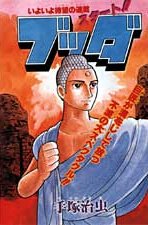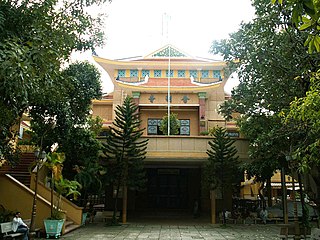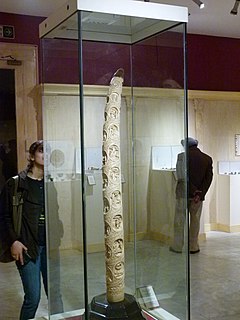
Gautama Buddha was an ascetic and spiritual teacher of South Asia who lived during the latter half of the first millennium BCE. He was the founder of Buddhism and is revered by Buddhists as a fully enlightened being who taught a path to Nirvana, freedom from ignorance, craving, rebirth and suffering.
The four sights are four events described in the legendary account of Gautama Buddha's life which led to his realization of the impermanence and the ultimate dissatisfaction of conditioned existence. According to this legend, before these encounters Gautama Siddhartha had been confined to his palace by his father, who feared that he would become an ascetic if he came into contact with sufferings of life according to a prediction. However, his first venture out of the palace affected him deeply and made him realize the sufferings of all, and compelled him to begin his spiritual journey as a wandering ascetic, which eventually led to his enlightenment. The spiritual feeling of urgency experienced by Siddhārtha Gautama is referred to as saṃvega.

Rāhula was the only son of Siddhārtha Gautama, and his wife, princess Yaśodharā. He is mentioned in numerous Buddhist texts, from the early period onward. Accounts about Rāhula indicate a mutual impact between Prince Siddhārtha's life and the lives of his family members. According to the Pāli tradition, Rāhula was born on the day of Prince Siddhārtha's renunciation, and was therefore named Rāhula, meaning a fetter on the path to enlightenment. According to the Mūlasarvāstivāda tradition, and numerous other later sources, however, Rāhula was only conceived on the day of Prince Siddhartha's renunciation, and was born six years later, when Prince Siddhārtha became enlightened as the Buddha. This long gestation period was explained by bad karma from previous lives of both Yaśodharā and of Rāhula himself, although more naturalistic reasons are also given. As a result of the late birth, Yaśodharā needed to prove that Rāhula was really Prince Siddhārtha's son, which she eventually did successfully by an act of truth. Historian H.W. Schumann has argued that Prince Siddhārtha conceived Rāhula and waited for his birth, to be able to leave the palace with the king and queen's permission, but Orientalist Noël Péri considered it more likely that Rāhula was born after Prince Siddhārtha left his palace.

Buddha is a manga drawn by Osamu Tezuka and is Tezuka's unique interpretation of the life of Gautama Buddha, the founder of Buddhism. The critically acclaimed series is often referred to as a visually explicit yet humorous and thought-provoking portrayal of the Buddha's life; the series itself has become a staple text in Buddhist temples for young adults and teens to learn about the Buddha's life. The series began in September 1972 and ended in December 1983, as one of Tezuka's last epic manga works.
Rohiṇī was a princess of the Śākyas and sister of Anuruddha. She is a Śrotāpanna.
Kshanti or khanti (Pāli) is patience, forbearance and forgiveness. It is one of the pāramitās in both Theravāda and Mahāyāna Buddhism.
The Anoma was a river in Majjhimadesa of ancient India. According to Buddhist tradition it was situated near Kapilavastu, and was crossed by Prince Siddhartha where he renounced the world before becoming the Buddha by cutting off his hair, abandoning his royal dress and exchanging it for the robes of an ascetic.

The miracles of Gautama Buddha refers to supernatural feats and abilities attributed to Gautama Buddha by the Buddhist scriptures. The feats are mostly attributed to supranormal powers gained through meditation, rather than divine miracles. Supranormal powers the historic Buddha was said to have possessed and exercised include the six higher knowledges (abhiññā): psychic abilities (iddhi-vidhā), clairaudience (dibba-sota), telepathy (ceto-pariya), recollection of one's own past lives (pubbe-nivāsanussati), seeing the past lives and rebirths of others (dibba-cakkhu), and the extinction of mental intoxicants (āsavakkhaya). Miracles found in Mahayana sutras generally play a more direct role in illustrating certain doctrines than miracles found in non-Mahayana Buddhist texts.

Kaundinya, also known as Ājñātakauṇḍinya, Pali: Añña Koṇḍañña), was a brahmin, who was one of the first five Buddhist monks (Pancavaggiya), follower of Gautama Buddha and the first to become an arhat. He lived during the 6th century BCE in what are now Uttar Pradesh and Bihar, India. According to traditional accounts, at the time of Gautama Buddha's birth, he predicted his future destination as an enlightened teacher.

According to Buddhist legend, Kanthaka was a favourite white horse of length eighteen cubits that was a royal servant of Prince Siddhartha, who later became Gautama Buddha. Siddhartha used Kanthaka in all major events described in Buddhist texts prior to his renunciation of the world. Following the departure of Siddhartha, Kanthaka died of a broken heart.

Assaji was one of the first five arahants of Gautama Buddha. He is known for his conversion of Sariputta and Mahamoggallana, the Buddha's two chief male disciples, counterparts to the nuns Khema and Uppalavanna, the chief female disciples. He lived in what is now Uttar Pradesh and Bihar in northern India, during the 6th century BCE.
Anuruddha was one of the ten principal disciples and a cousin of Gautama Buddha.

The Xá Lợi Temple is the largest temple in Hồ Chí Minh City, Vietnam. It was built in 1956 and was the headquarters of Buddhism in South Vietnam. The temple is located in District 3, Hồ Chí Minh City and lies on a plot of 2500 square metres. The name Xá Lợi is the Vietnamese translation for śarīra, a term used for relics of Buddhists.
The Buddha was born into a noble family of the Khattiyas in Lumbini in 563 BCE as per historical events and 624 BCE according to Buddhist tradition. He was called Siddhartha Gautama in his childhood. His father was king Śuddhodana, leader of the Shakya clan in what was the growing state of Kosala, and his mother was queen Maya. According to Buddhist legends, the baby exhibited the marks of a great man. A prophecy indicated that, if the child stayed at home, he was destined to become a world ruler. If the child left home, however, he would become a universal spiritual leader. To make sure the boy would be a great king and world ruler, his father isolated him in his palace and he was raised by his mother's younger sister, Mahapajapati Gotami, after his mother died just seven days after childbirth.

Asita or Kaladevala or Kanhasiri was a hermit ascetic depicted in Buddhist sources as having lived in ancient India. He was a teacher and advisor of Suddhodana, the father of the Buddha, and is best known for having predicted that prince Siddhartha of Kapilavastu would either become a great chakravartin or become a supreme religious leader; Siddhartha was later known as Gautama Buddha.

The ten principal disciples were the main disciples of Gautama Buddha. Depending on the scripture, the disciples included in this group vary. In many Mahāyāna discourses, these ten disciples are mentioned, but in differing order. The ten disciples can be found as an iconographic group in notable places in the Mogao Caves. They are mentioned in Chinese texts from the fourth century BCE until the twelfth century CE, and are the most honored of the groups of disciples, especially so in China and Central Asia. The ten disciples are mentioned in the Mahāyāna text Vimalakīrti-nideśa, among others. In this text, they are called the "Ten Wise Ones", a term which is normally used for the disciples of Confucius.

Buddhism is a religion and philosophy encompassing a variety of traditions, beliefs and practices, largely based on teachings attributed to Siddhartha Gautama, commonly known as the Buddha, "the awakened one".

The Legend of Buddha is a 2004 Indian animated film directed by Shamboo Falke, produced by Stalin Saravanan and written by Caarthick Raju and Ramesh Karthikeyan. The film tells the story of Prince Siddhartha Gautama, who leaves his kingdom to become the spiritual leader, Buddha. The film was selected for the Academy Award for Best Animated Feature at the Academy Awards.

Carved elephant tusk depicting Buddha life stories is an intricately carved complete single tusk now exhibited at the Decorative Arts gallery, National Museum, New Delhi, India. This tusk was donated to the Museum. This tusk, which is nearly five foot long, illustrates forty three events in the life of the Buddha and is thought to have been made by early 20th century craftsmen from the Delhi region.

The Great Renunciation or Great Departure is the traditional term for the departure of Gautama Buddha from his palace at Kapilavastu to live a life as an ascetic. It is called the Great Renunciation because it is regarded as a great sacrifice. Most accounts of this event can be found in post-canonical Buddhist texts from several Buddhist traditions, which are the most complete. These are, however, of a more mythological nature than the early texts. They exist in Pāli, Sanskrit and Chinese language.













